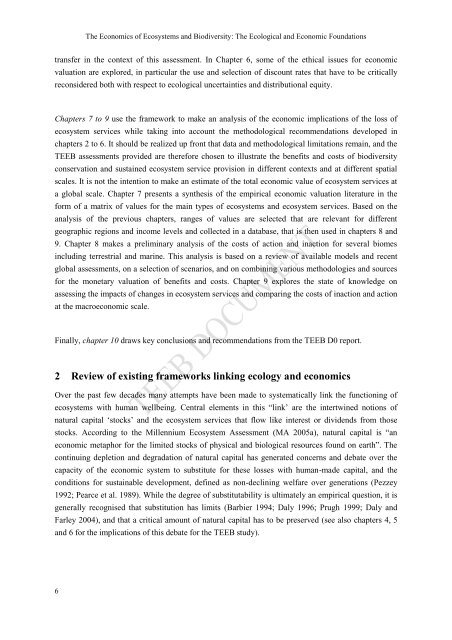Chapter 1 Framework of integration of ecology and economy ... - TEEB
Chapter 1 Framework of integration of ecology and economy ... - TEEB
Chapter 1 Framework of integration of ecology and economy ... - TEEB
You also want an ePaper? Increase the reach of your titles
YUMPU automatically turns print PDFs into web optimized ePapers that Google loves.
The Economics <strong>of</strong> Ecosystems <strong>and</strong> Biodiversity: The Ecological <strong>and</strong> Economic Foundationstransfer in the context <strong>of</strong> this assessment. In <strong>Chapter</strong> 6, some <strong>of</strong> the ethical issues for economicvaluation are explored, in particular the use <strong>and</strong> selection <strong>of</strong> discount rates that have to be criticallyreconsidered both with respect to ecological uncertainties <strong>and</strong> distributional equity.<strong>Chapter</strong>s 7 to 9 use the framework to make an analysis <strong>of</strong> the economic implications <strong>of</strong> the loss <strong>of</strong>ecosystem services while taking into account the methodological recommendations developed inchapters 2 to 6. It should be realized up front that data <strong>and</strong> methodological limitations remain, <strong>and</strong> the<strong>TEEB</strong> assessments provided are therefore chosen to illustrate the benefits <strong>and</strong> costs <strong>of</strong> biodiversityconservation <strong>and</strong> sustained ecosystem service provision in different contexts <strong>and</strong> at different spatialscales. It is not the intention to make an estimate <strong>of</strong> the total economic value <strong>of</strong> ecosystem services ata global scale. <strong>Chapter</strong> 7 presents a synthesis <strong>of</strong> the empirical economic valuation literature in theform <strong>of</strong> a matrix <strong>of</strong> values for the main types <strong>of</strong> ecosystems <strong>and</strong> ecosystem services. Based on theanalysis <strong>of</strong> the previous chapters, ranges <strong>of</strong> values are selected that are relevant for differentgeographic regions <strong>and</strong> income levels <strong>and</strong> collected in a database, that is then used in chapters 8 <strong>and</strong>9. <strong>Chapter</strong> 8 makes a preliminary analysis <strong>of</strong> the costs <strong>of</strong> action <strong>and</strong> inaction for several biomesincluding terrestrial <strong>and</strong> marine. This analysis is based on a review <strong>of</strong> available models <strong>and</strong> recentglobal assessments, on a selection <strong>of</strong> scenarios, <strong>and</strong> on combining various methodologies <strong>and</strong> sourcesfor the monetary valuation <strong>of</strong> benefits <strong>and</strong> costs. <strong>Chapter</strong> 9 explores the state <strong>of</strong> knowledge onassessing the impacts <strong>of</strong> changes in ecosystem services <strong>and</strong> comparing the costs <strong>of</strong> inaction <strong>and</strong> actionat the macroeconomic scale.Finally, chapter 10 draws key conclusions <strong>and</strong> recommendations from the <strong>TEEB</strong> D0 report.2 Review <strong>of</strong> existing frameworks linking <strong>ecology</strong> <strong>and</strong> economicsOver the past few decades many attempts have been made to systematically link the functioning <strong>of</strong>ecosystems with human wellbeing. Central elements in this “link‟ are the intertwined notions <strong>of</strong>natural capital „stocks‟ <strong>and</strong> the ecosystem services that flow like interest or dividends from thosestocks. According to the Millennium Ecosystem Assessment (MA 2005a), natural capital is “aneconomic metaphor for the limited stocks <strong>of</strong> physical <strong>and</strong> biological resources found on earth”. Thecontinuing depletion <strong>and</strong> degradation <strong>of</strong> natural capital has generated concerns <strong>and</strong> debate over thecapacity <strong>of</strong> the economic system to substitute for these losses with human-made capital, <strong>and</strong> theconditions for sustainable development, defined as non-declining welfare over generations (Pezzey1992; Pearce et al. 1989). While the degree <strong>of</strong> substitutability is ultimately an empirical question, it isgenerally recognised that substitution has limits (Barbier 1994; Daly 1996; Prugh 1999; Daly <strong>and</strong>Farley 2004), <strong>and</strong> that a critical amount <strong>of</strong> natural capital has to be preserved (see also chapters 4, 5<strong>and</strong> 6 for the implications <strong>of</strong> this debate for the <strong>TEEB</strong> study).6
















